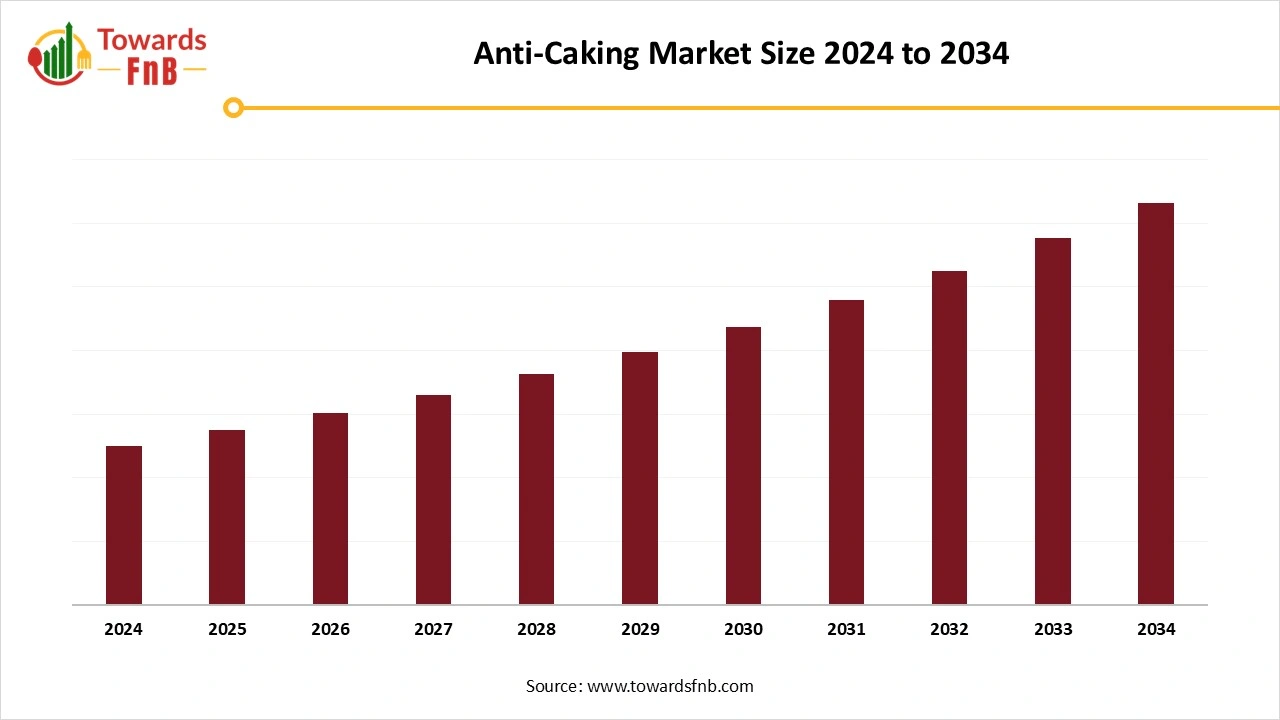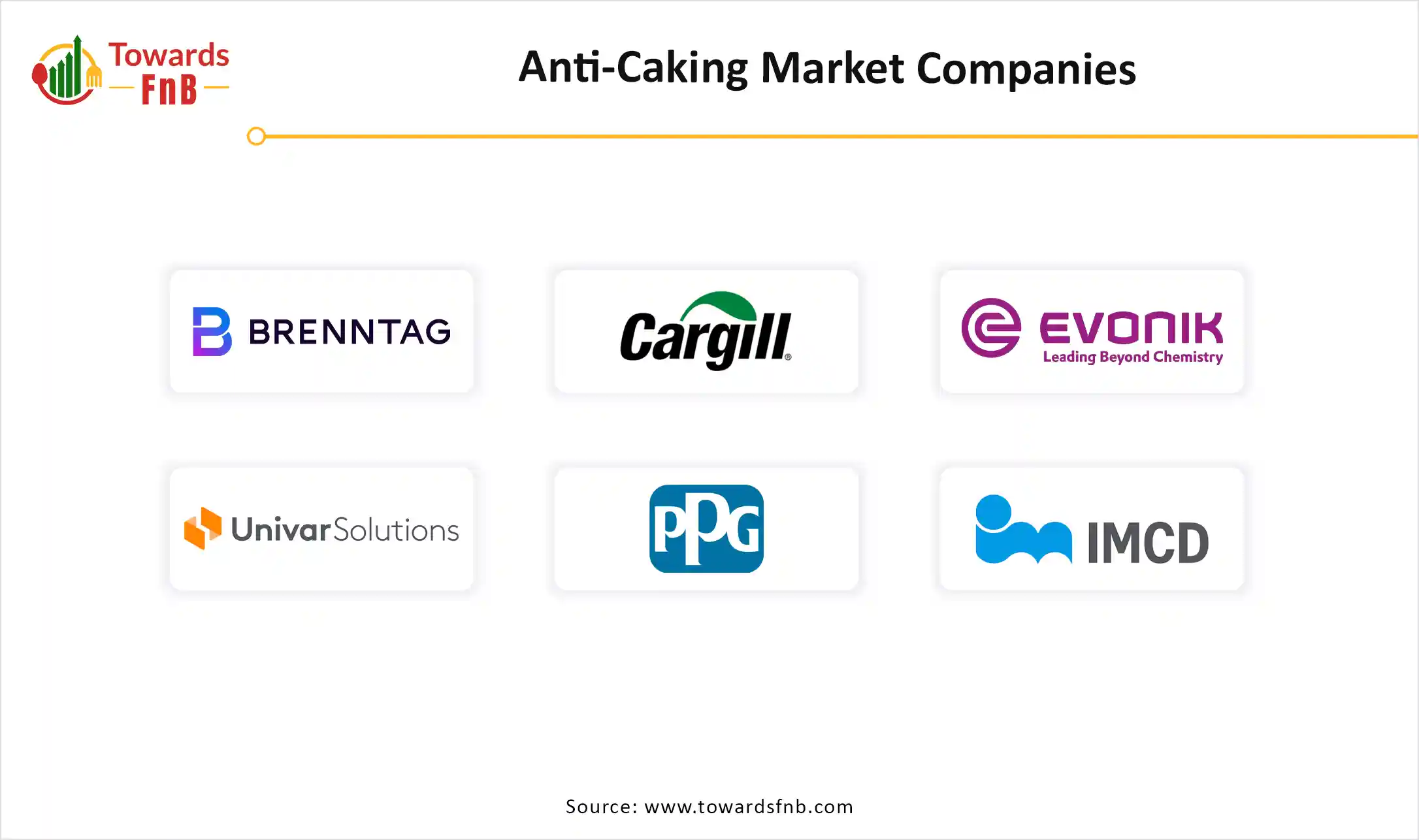December 2025
The global anti-caking market is positioned for rapid expansion, with projected revenue increases over the next decade, spurred by the widespread efforts by key players across the globe. The market growth is attributed to the increasing consumption of food anti-caking agents.

The anti-caking market deals with processes aimed at preventing the sticking and clumping together of granulated or powdered substances. Due to the absorption of substances, this initiative often occurs, causing particles to form lumps. To maintain the free and loose-flowing texture, anti-caking agents are additives or substances integrated into various products, including powdered food, spices, and salt. Anti-caking agents are creating a challenge that impedes the particles from binding and minimizes friction. In addition, to enhance product quality by preventing undesirable clumps during usage and storage, is a major use of anti-caking, which is expected to drive the market growth.
One of the major factors driving market growth is preventing the formation of lumps, maintaining product quality, and guaranteeing fluidity. In addition, this component helps to prevent moisture that has been absorbed, thereby increasing the food product’s shelf life. Furthermore, the increasing demand for convenience and processed foods is another driving factor that contributed to propelling the market. To maintain the integrity and quality of granulated or powdered products, the need for effective anti-caking agents becomes vital, as the consumer base embraces a diverse range of food products across the country. These crucial factors are expected to drive the growth of the market during the forecast period.
The future of anti-caking is characterized by sustainability, customization, and innovation. To create advanced solutions that meet the changing needs of industries and consumers, manufacturers are expected to invest in research and development, as the ng market continues to emerge. The market for anti-caking is poised for significant growth in the coming years, with an increasing focus on market expansion, technological advancements, and clean label ingredients. Various companies can position themselves for success in the competitive and dynamic market, by collaborating with industry partners, embracing new technologies, and staying abreast of key trends. These innovative trends are further expected to enhance the growth of the anti-caking market in the coming years.
The major challenge surrounding anti-caking in processed foods is their environmental effect. Many of these additives are manufactured from natural sources including minerals and clay, which creates major challenges about the potential for pollution and depletion of natural resources during the manufacturing and extraction process. In addition, the disposal of packaging containing anti-caking can also contribute to environmental pollution and waste. Thereby, the controversies and challenges surrounding anti-caking in processed foods highlight the complicated interplay between regulatory, environmental, and health factors, which further restrain the growth of the anti-caking market.
North America Dominated the Anti-Caking Market in 2024.
The market growth in the region is attributed to the increasing demand for a diverse range of food ingredients and the increasing consumption of processed food. In addition, increasing demand for high-quality food products, increasing demand for anti-caking agents, and rising demand for ready-to-eat and convenience food products are expected to drive the market growth in the region. Anti-caking is necessary for preserving the functionality and quality of powdered products, in food and industrial applications in the region. To prevent clumping, anti-caking is used in products such as baking mixes, seasonings, and powdered milk, in food processing, which contributed to propel the market in the region. The U.S. and Canada are dominating countries propelling market. The increasing demand for anti-caking agents in both non-food and food industries such as industrial chemicals and fertilizers and large agriculture and food industries are further expected to drive the anti-caking market in the U.S. Companies such as BASF and DoW Chemical are offering a variety of anti-caking solutions in the U.S.
Asia Pacific is Expected to Grow Fastest During the Forecast Period.
The market growth in the region is driven by the increasing growth for food anti-caking in various food and beverage sectors, increasing disposable incomes, growing urbanization, increasing demand for packaged and processed foods, and growing preference towards natural and innovative anti-caking solutions. China, India, Japan, and South Korea are the fastest growing countries driving the market in the region. India and China are the fastest growing countries drive the market growth.
India is the second fastest growing country in the food and beverage industry driven by increasing demand for stable and cost-effective solutions, growing pharmaceutical industry, rapid industrialization, and increasing demand for anti-caking agents. The increasing demand for convenience and ready-to-eat foods has led to developments in food packaging, storage, and flavor enhancement. To ensure free-flowing and smooth products and prevent particle clumping, they play an important role in this evolution. These anti-caking agents are vital for maintaining nutritional value, increasing shelf life, and food preservation. Anti-caking is becoming increasingly vital in the food industry, as the anti-caking market grows due to evolving consumer preferences and innovations.
The Calcium Compounds Segment Dominated the Anti-Caking Market in 2024.
The calcium compounds are suitable for use in food products incorporated to high temperatures, including instant foods and baking mixes. It plays an important role in maintaining product quality and widely used compounds. In food manufacturing and pharmaceuticals, preventing clumping and keeping products free-flowing is necessary. It helps to compromise product efficiency and safety standards and enhance consumer satisfaction. In addition, enhancing tablet formulation, improving shelf life and stability, maintaining the quality of seasonings and powdered foods, regulatory approval, ensuring accurate product dispensing and measurement, maintaining product texture, flavor, and stability, and keeping products dry are the major advantages of calcium compounds which are expected to drive the segment growth.
The Sodium Compounds Segment Expected the Fastest Growth in the Market During the Forecast Period.
Silicon compounds are a major component of the human diet and are used in a wide range of food products, such as dessert mixes, coffee, and powdered seasonings. It prevents caking in hygroscopic food items, allowing efficiently absorbing moisture, and has a high surface area. Sodium compounds are used as table salt. By adding some rice to a saltshaker, caking can easily. In addition, the increasing application of techniques to provide sodium compounds and increasing quantity of baking soda in various are further expected to drive the segment growth.
The Food and Beverage Segment Dominated the Anti-Caking Market in 2024.
The segment growth in the market is driven by increasing demand for ingredients that reduce sugar content across various categories, including soups, sauces, confectionery, dairy, bakery, and beverages, and the increasing use of natural and artificial sugar substitutes. The food and beverages have undergone various testing to analyze safety and efficacy, which is further anticipated to drive the segment growth in the market. In addition, the increasing demand for anti-caking technologies, increasing consumer desire for convenience and packaged foods coupled with strict food safety regulations, and increasing need for anti-caking compounds in powdered products, salt, spices, processed foods, and others are further contributed to propelling the market growth.
The Feed Segment is Expected to Grow Fastest During the Forecast Period.
The segment growth in the anti-caking market is driven by increasing demand for sustainable feed, growing usage in feed formulations, rising technological advancements in the natural feed anti-caking solutions, and the rising adoption of new technologies in feed anti-caking production. Feed producers are looking for additives to traditional synthetic anti-caking, as customer demand for organic dairy and meat products grows, which drives market growth.
MR KIPLINK
NOMO

By Type
By Application
By Region
December 2025
December 2025
December 2025
December 2025